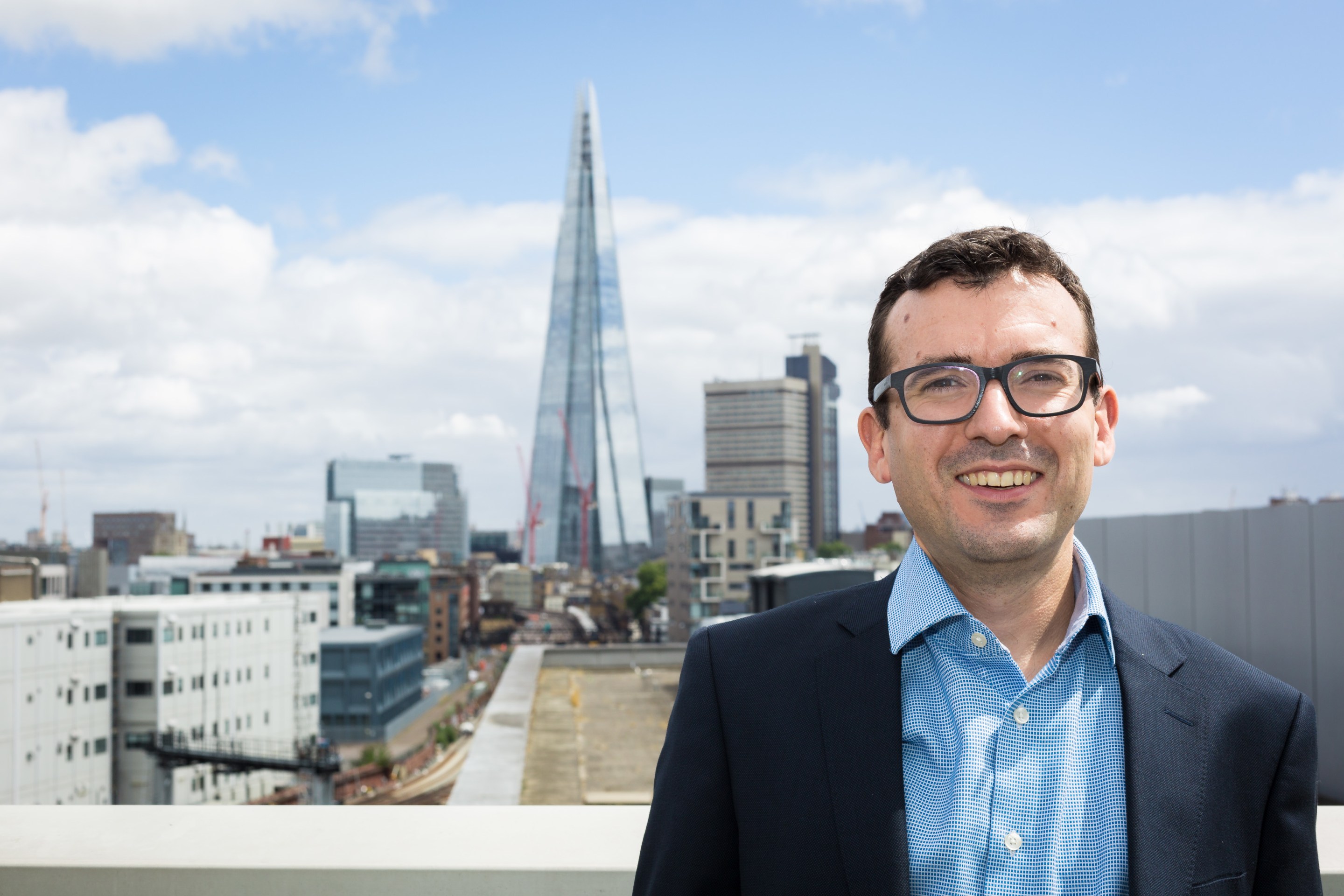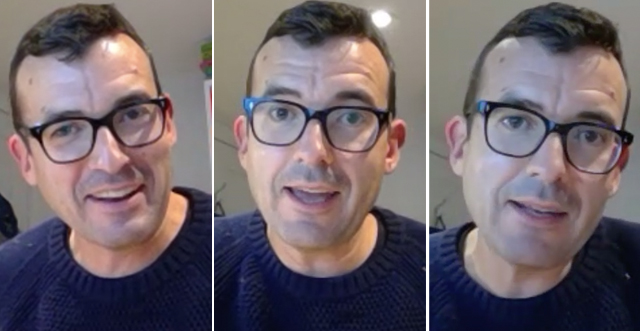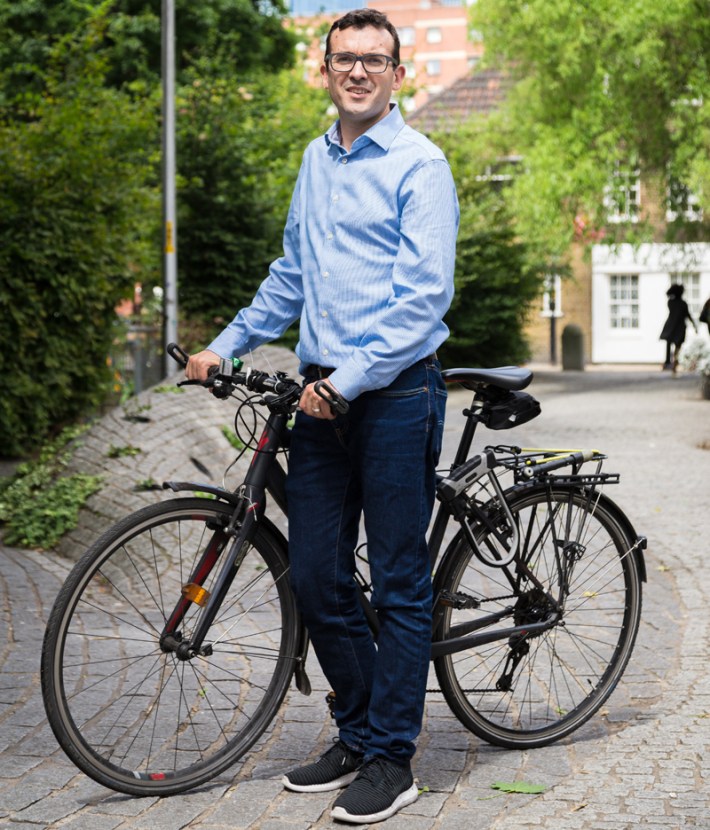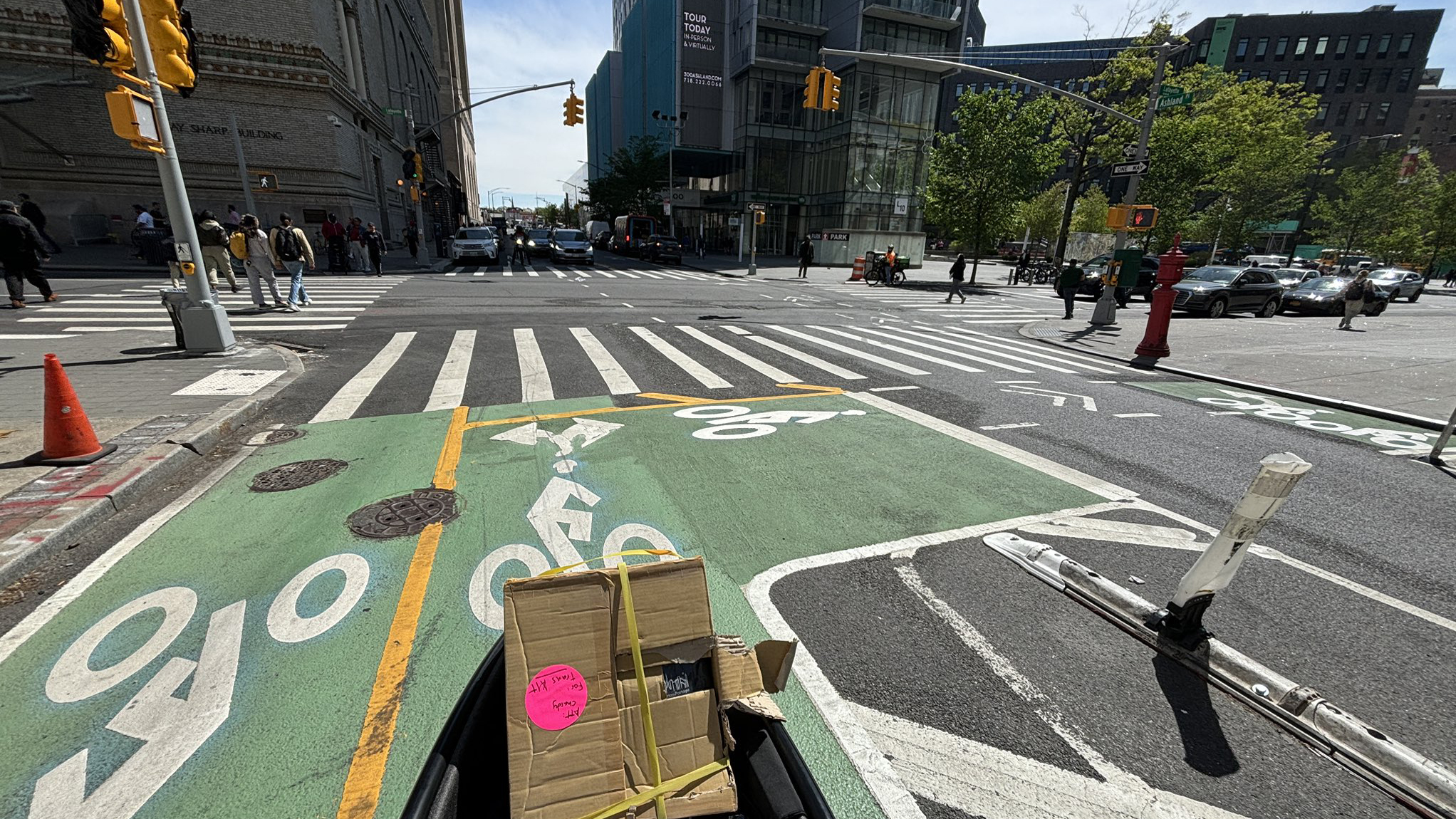The Streetsblog Interview: Will Norman
12:01 AM EST on November 9, 2020

Will Norman, London’s Walking and Cycling Commissioner.
COVID is telling us what kind of cities we need to build: cleaner, more sustainable, more equitable and less oppressed by automobiles. In London, Mayor Sadiq Khan — who was already undertaking an ambitious expansion of transit, cycling, walking and just hanging — doubled down in hopes of not only reducing the spread of the disease, but building a better city going forward. New York City did not undertake nearly as ambitious a plan as London or other major cities, running the risk (as experts long pointed out) of just returning to the original car-choked "normal" when this is all over. So we called up London’s Walking & Cycling Commissioner, Will Norman, for advice. Number one: "the transport system has to own the health agenda," he said. Here's a slightly edited transcript of Norman's Zoom chat with Streetsblog NYC Editor Gersh Kuntzman.
Streetsblog: First, let's go over everything London did during the pandemic in terms of new protected cycle paths, new public space, etc. just to set a benchmark. Describe in short the Mayor’s Streetspace Plan. I saw lots of proposals, but what did you end up actually building?
Will Norman: This isn't something new in London. When the mayor came in, he had a specific transport plan to shift people from non-sustainable transport to sustainable. At that time, 63 percent of all journeys in London were sustainable — walking, cycling public transport. The goal was to get to 80 percent of sustainable modes. Over the four years of his term [COVID delayed an election that was supposed to happen in May], we had tripled the number of protected cycle lanes in those years. And what happened was the highest increase in cycling on record.
COVID came along ... and we had this lockdown. It was fascinating to see this massive drop in car traffic. Streets were quiet. One of the joys of that period was actually seeing families cycling around their neighborhoods. People walking to their local stores to do their emergency shopping. People using their local streets to get to parks and exercise. As the lockdown restrictions eased, we saw the public transport data — only a small return of the Underground from about 5 percent to only 30 percent. And the buses returned to about 50 percent. That means millions of journeys having to be made by another mode. And if that mode was cars, we would end up with gridlock and a toxic air crisis, which is the very last thing you need in a respiratory disease pandemic.

So we thought, "We've got a long-term problem." We knew we had to reallocate roadway space. COVID showed that if people feel safe, they will cycle. That's proven beyond all doubt. So we had to do that rapidly. So our plan for the three key areas — 50 km (31 miles) of protected cycle lanes; wider footways around shops and pedestrianized areas for restaurants and retail; and creating 30 of what we call "low-traffic neighborhoods," closing off some of the streets, including closing off about 100 streets around schools at drop-off and pick-up times (because a quarter of a million car journeys in London every day are associated with the school run, most of which are very local journeys that could be made sustainably).
Those were the goals, but in the end, our six-month program created 90 km (56 miles) of cycle lanes, 96 low-traffic neighborhoods (with 35 more proposed); 22,000 square meters of extended sidewalk space, 71 town center schemes have been improved and we have 305 new school streets. And we did some additional things:
- We expanded the 20 mile-per-hour speed limits to cover 20 km (12 miles) more roads, which is critical to safety.
- We made 86 km (53 miles) of our bus lanes, which operated during some hours part of the day, in 24-7 bus lanes.
The previous administration would do about 50 kms of bike lanes in eight years. Our team has delivered what used to take months and years in days and weeks.
Streetsblog: There is community opposition to such moves, though, right? So how do you deal with that? People are so afraid of change.
Will Norman: It's still playing a role. Let's be honest, these were emergency measures. We didn't need to do the same level of consultation because these are temporary measures. To convert these measures to permanent measures, we have to engage and consult, but we have an 18-month timeframe to make those changes. Clearly, not everything is great or perfect, but we're not going to wait 18 months to start talking to people. And engaging. We are making tweaks and changes all the time. Some things were removed because they didn't work, and some things were expanded because they needed to happen.
Any change, particularly involving streets and transport, is controversial. Mention cycling in some areas and it's like a red rag to a bull. We are continuing to manage some of that opposition. Over time, as things get bed in — and they do need time to bed in — we see the majority of people wanting it. We are seeing surveys reflecting that.
New data from @tfl shows that cycling on Kensington High Street has more than doubled to over 3000 per day - all enjoying @RBKC's great new cycle lane.🚲🚲 When we make streets safer, many more people cycle - helping free up space on public transport & roads for those who can't. pic.twitter.com/9JVDQnTI53
— Will Norman (@willnorman) November 2, 2020
Streetsblog: Cars fail on every level — they are deadly, they pollute our cities with noise and exhaust, and they take up too much space. Yet they are the time-honored technology that everyone seems to accept, yet when you bring in more sustainable modes, you get this negative reaction from people clinging to this outdated, dangerous, polluting unsustainable, technology.
Will Norman: We have a shadow of that. London is an old city. Only for one-tenth of its existence have there been cars. yet the whole design of the city has been transformed around the car. And the mentality you mentioned is so prevalent. The car industry over decades has invested billions and billions of pounds globally and it sold as freedom. It is seen as a right.
Streetsblog: One of your countrymen once wrote that "Freedom is slavery."
Will Norman: I'm not "anti-car," but the balance needs to swing to other modes. We can't have a city with no motor vehicles in it, but every person who cycles, that's more space for people who can't. It improves the air quality and public health. Not every journey can be made by bike, but many can.
Streetsblog: Talk to me about basic health. I understand London has a "Healthy Streets" approach, which we've covered, that considers the negative mental health affects of noise and pollution when it makes changes to the streetscape. Can you explain that to me, because our Department of Health and Mental Health in New York City has literally no involvement at all in informing decisions about road design.
Will Norman: We actually had a public health professional sit within the transport system to develop our Healthy Streets approach. It was not just engaging them, it was thinking, "As a transport authority, we have to take public heath seriously." That goes into all areas. there are obvious ones, such as air pollution and Vision Zero. But also the physical inactivity crisis is overlooked and the scale of the implications of it. There are many ways to get people active but you have to design it into their lives. Talking about sport is not going to work for someone who is inactive. But if you can say, "Get off the bus a stop earlier" or "Walk your kids to school," those benefits reduce mortality by 20 percent.
Streetsblog: Our health department knows that, but its efforts are not connected to the streetscape
Will Norman: The transport system has to own the health agenda. Unless the transport agencies are responsible for the health outcomes, it won't happen. The health system right now is stretched every way, so it's astonishing what impact a transport authority can have, not just on physical health, but on mental health: levels of depression, anxiety, etc.. It's remarkable the impact that our streets and our urban landscape can have our health outcomes, particularly in disadvantaged communities. Historically, medical institutions don't take prevention seriously enough. They deal with treatment. So there's a societal role here. It goes beyond the medical profession.
More than 120 doctors and nurses have written to the Mayor in support of Streetspace & Low Traffic Neighbourhoods - they call on council leaders across the capital to continue with the changes to promote more walking, cycling & healthier lifestyles https://t.co/xC2OLZCL6i
— Will Norman (@willnorman) November 4, 2020
Streetsblog: So that's your "low-traffic neighborhood" idea?
Will Norman: A low-traffic neighborhood is essentially a traffic cell with the main roads and the residential streets. We've seen a massive increase in rat-running through the local streets with the increase in traffic and the use of sat navs. The point is to make it easier for people to walk and cycle for those local journeys. So you put in filters. They're often just big flowerpots in the street. It disincentivizes people to move through an area. People can still get deliveries and their waste picked up in a dumptruck, but it reduces the traffic moving through an area. ... It also results in not just traffic dispersal, but in traffic evaporation because people shift their modes. In one area of London, we are seeing people walking and cycling 42 minutes more a week than before. That's a shift in mode. Plus people plan their journeys differently so they don't drive through an area.

It's also good for business, and I know businesses owners are often a vocal opposition, but pedestrians are spending 30 percent more and there is 40-percent more foot traffic and 17 percent fewer empty retail properties. We call that the "pedestrian pound." This is good for business on the whole.
Streetsblog: So what's the goal here? Is there something about wanting to come back as a different, better city? I was at a press conference recently and a local politician [Council Member Brad Lander] said, "COVID is telling us what kind of city we need to have in the future." And Joe Biden is saying, "Build it back better." And Rahm Emanuel always said "You never let a crisis go to waste." Is that the goal here — to simply be a better London when this is all over?
Will Norman: We're going to have to build it back better. We're not going to go back to the way it was. But it's funny: From a policy perspective, COVID has changed everything, but COVID has also changed nothing. It's the same challenges. COVID is an immediate crisis, but the environmental crisis that's looming makes COVID pale by comparison. This is a shift that needs to happen. It has been happening, but this is accelerating it. We have to learn from this. We can't only do emergency measures. We need to engage with communities over how people move around our cities, how the town center works so it's a 15-minute city, etc. The approach we took during COVID is part of a longer journey that we need to get on with.
First 4 seconds: “See, why are we wasting money & space on bike-lanes nobody’s using?”
— Brent Toderian (@BrentToderian) October 23, 2020
Rest of the video: “...oh...well, it must be flat there.”
More people moving in less space with less public cost, emissions, health care costs etc. HT @CyclingWorksLDN pic.twitter.com/hEksGLYERd
Streetsblog: It's funny to hear that because in New York, I feel we will go back to being basically the same city — maybe a few more bike lane miles every year, a few more dedicated bus lanes, but a fundamental redesign of New York City? I've been here for 30 years and it doesn't feel possible. I mean, you have a prime minister who may be a conservative, but he's also a cyclist! We can't even get the mayor on a bike or on the subway! So can you offer any advice to New Yorkers?
Will Norman: Only three things drive change: political leadership, the technical expertise of the people who do the engineering, and activists.
Now, political leadership can change, which can lead to new people being brought in to do the engineering. And that's happening. Just like doctors have been trained just to fight diseases, a lot of highway engineers have been trained to just move cars around. You need the innovation there, and we are seeing some brilliant young people, often women, coming through the system now.
But that third part — activists — is crucial. You can have political leadership and the right engineers, but without that community infrastructure, it won't work. And COVID has shown in London what could be possible and that has inspired people to say, "Actually, I like it when my kids can go safely to the park without being run over. I like it that I can hear birdsong on my road. I like it when I can cycle to my local shops. My shopkeepers like me shopping in my local store instead of driving to some out-of-town mall. There are aspects of this that I'd like to keep."
That's inspired new people, who have not been the traditional cycling advocates, and that is what brings me so much hope. People have seen a glimpse of what's possible and they are the ones who are standing up for it at the school gates and advocating for more. And you can't put that back in a bottle. Political leadership changes and engineers change, but you can't put that vision of the future back. That's where I see hope. It's not uniform across the city, but where the pockets of it exist, you can tell that story because people in other neighborhoods say, "Wait a second, how come we don't have that?" And that, to me, becomes contagious.
Streetsblog: Like 34th Avenue in Queens.
Will Norman: We had a couple of those kinds of "beacons" and they have been working well. If you have 96 low-traffic neighborhoods, not all of them are successful, but the ones that are successful become an exponential growth. People see it and want it for their neighborhood. And then that leads to electoral power. If you look at our local elections, people who have delivered streetscape changes have won re-election. It's a vote getter. Politicians are realizing, "This is a good thing for me."
Streetsblog: You sound so optimistic.
Will Norman: You have to be in this job.
This piece was the work of the Streetsblog staff.
Read More:
Stay in touch
Sign up for our free newsletter
More from Streetsblog New York City
DOT Aims to Build First Ave. Tunnel Bike Lane Before September’s UN General Assembly
DOT hopes to have the concrete-protect tunnel bike lane installed this summer, but its exact plans are still in development.
Waste Reforms Could Require Data on Crashes, Dangerous Driving
The proposal affects at least one trucking company with a deadly driving record.
When it Comes to Federal Infrastructure Grants, Size Does Matter
Cities and municipalities with larger budgets and staff are more likely to win competitive federal infrastructure grants, the Urban Institute has found.
Tuesday’s Headlines: Real Estate Greed Against Good Bike Lane Design Edition
A real estate developer's opposition to the Ashland Place protected bike lane yields some baffling bike lane markings. Plus more news.
City Considers Fixes for Another Ridiculously Slow Cross-Bronx Bus
Potential bus improvements are on the table for the Bronx's Tremont Avenue, but the Adams administration's failures on nearby Fordham Road loom large.




